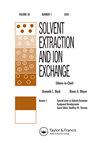用于实验室规模逆流多级溶剂萃取的模块化环形离心接触器的设计
IF 2.1
4区 化学
Q3 CHEMISTRY, MULTIDISCIPLINARY
引用次数: 0
摘要
摘要环形离心接触器(ACC)作为逆流多级溶剂萃取(SX)设备具有吸引人的性能,允许在短停留时间内实现高产量、小液体滞留和小占地面积。实验室规模ACC的商业供应商数量有限,其设计灵活性有限。商业25 mm直径的ACC采用透明PMMA在混合区周围进行定制,允许对操作故障进行可视化过程监控和识别。与工厂设计相比,几个转子的分离区延长了,这允许在改进的接触器中更长的平均停留时间,同时保持互连接触器组中的有机流速恒定。Couette间隙可以在不影响混合性能的情况下增大或减小。3D打印的定子允许更有效地排出轻相和重相,并减少液体滞留和有效实现工艺中稳态条件所需的体积。通过TBP铀SX工艺验证了改进设备的流体力学性能。首先,在SX过程模拟软件中,利用HNO3和在十二烷中稀释的30%TBP中铀的分布比的文献数据集来创建经验模型。设计了一个流程图来验证该模型,并提供了一个从分批过程到多阶段过程的方法示例。在线密度测量用于监测和控制铀浓度,并实现所需的高金属负载稳态条件。研究表明,在洗涤段混合区停留时间较长的改性ACC中,可以改善铀对钌的净化。本文章由计算机程序翻译,如有差异,请以英文原文为准。
Design of a Modular Annular Centrifugal Contactor for Lab-Scale Counter-Current Multistage Solvent Extraction
ABSTRACT Annular centrifugal contactors (ACCs) have appealing properties as counter-current multistage solvent extraction (SX) equipment, allowing high throughput at short residence times, small liquid hold-up, and small footprint. The number of commercial suppliers of laboratory-scale ACCs is limited, and their designs have restricted flexibility. Commercial 25 mm diameter ACCs were customized with transparent PMMA surroundings of the mixing zones, allowing visual process monitoring and identification of operational malfunctions. The separation zone of several rotors was lengthened compared to the factory design, which allows longer average residence times in the modified contactors, while keeping the organic flow rate constant in the bank of interconnected contactors. The Couette gap could be increased or decreased without affecting the mixing performance. A 3D-printed stator allows for more efficient draining of the light and heavy phases, and reduces liquid hold-up and volumes required to efficiently achieve steady-state conditions in the process. The hydrodynamic performance of the modified equipment was demonstrated by a SX process of uranium with TBP. First a literature data set of distribution ratios for uranium in HNO3 and 30% TBP diluted in dodecane was utilized to create an empirical model in SX Process simulation software. A flowsheet was designed to validate the model, and it provides an example of the methodology to progress from batch to multistage process. Online density measurements were used to monitor and control the uranium concentrations, and to achieve the desired high metal loading steady-state conditions. It was demonstrated that ruthenium decontamination from uranium could be improved in modified ACCs with longer residence time in the mixing zones of the scrubbing section.
求助全文
通过发布文献求助,成功后即可免费获取论文全文。
去求助
来源期刊
CiteScore
4.40
自引率
5.00%
发文量
15
审稿时长
8.4 months
期刊介绍:
Solvent Extraction and Ion Exchange is an international journal that publishes original research papers, reviews, and notes that address all aspects of solvent extraction, ion exchange, and closely related methods involving, for example, liquid membranes, extraction chromatography, supercritical fluids, ionic liquids, microfluidics, and adsorption. We welcome submissions that look at: The underlying principles in solvent extraction and ion exchange; Solvent extraction and ion exchange process development; New materials or reagents, their syntheses and properties; Computational methods of molecular design and simulation; Advances in equipment, fluid dynamics, and engineering; Interfacial phenomena, kinetics, and coalescence; Spectroscopic and diffraction analysis of structure and dynamics; Host-guest chemistry, ion receptors, and molecular recognition.

 求助内容:
求助内容: 应助结果提醒方式:
应助结果提醒方式:


